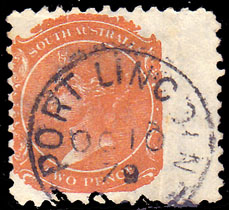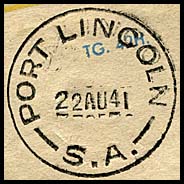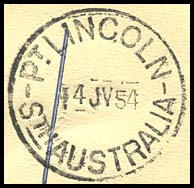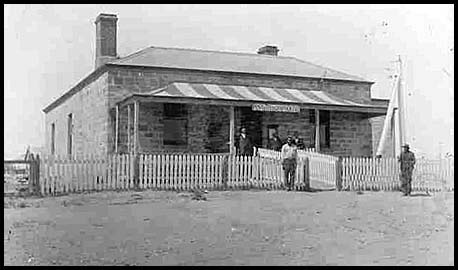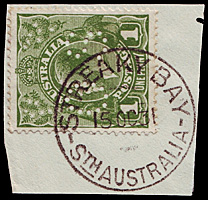Telegraph Offices on the Eyre Peninsula and west to Eucla.
- Home, index, site details
- Australia 1901-1988
- New South Wales
- Overview of NSW
- Telegraph lines
- Telegraph Offices
- Date stamps
- Forms
- Envelopes
- Rates
- Stamps
- Queensland
- Overview of Qld
- Telegraph lines
- Telegraph offices
- Date stamps
- Forms
- Envelopes
- Rates
- Stamps
- South Australia
- Overview of SA
- Telegraph lines
- Telegraph Offices
- Date stamps
- Forms
- Envelopes
- Rates
- Stamps
- Tasmania
- Overview of Tasmania
- General developments
- Reports
- Organisation
- Telegraph lines
- Telegraph Offices
- Date stamps
- Railway lines
- Forms
- Envelopes
- Rates
- Stamps
- Overview of Tasmania
- Victoria
- Overview of Vic.
- Telegraph lines
- Telegraph offices
- Date stamps
- Forms
- Envelopes
- Rates
- Stamps
- Ephemera
- Western Australia
- Overview of WA
- Telegraph lines
- Telegraph Offices
- Date stamps
- Forms
- Envelopes
- Rates
- Stamps
The following Telegraph Offices are included on this page:
| Arno Bay | Bramfield | Ceduna | Cowell | Fowlers Bay | Franklin Harbour |
| (Port) Elliston | Port Lincoln | Smoky Bay | Streaky Bay | Tarcoola | Yardea |
| Arno Bay.
There is no record of a Telegraph Office opening. A Receiving Office was opened on 1 January 1908. The ability to send a telegram seems to be intimated in many newspaper articles over a considerable period of time - and in the photograph below. A detailed review of newspaper stories does not reveal many details but at least confirms the existence - at some time - of an Arno Bay P&TO. |
|
|
In the House on 26 November 1878, Mr. Coglin asked "Is it the intention of the Government to form a telegraph station at the township of Bramfield West?" The Treasure replied "Provision is made on the Estimates for 1878-79 for a Telegraph Station at Bramfield". On 1 November 1879, the Adelaide Observer printed the following: THE WANTS OF BRAMFIELD.
The Post Office had opened on 15 August 1862. A Telegraph and Telephone service was opened at Bramfield on 14 August 1924 (46 years after the House undertaking!!). |
| Ceduna.
No Telegraph Office was ever opened at Ceduna. Ceduna was, however, a base for the Royal Flying Doctor during the 1950s from which to serve South Australia Radio Telegraph offices and many outlying Radio Telegraph stations. The area was surveyed in the late 1890s and proclaimed as Murat Bay where a Post Office was opened in April 1898. The name of the town was changed to Ceduna in 1901 although the name of the Post Office did not change until 1 January 1922. Ceduna is about 726 km from Adelaide and the RFDS estimates it is about 200 nautical miles by air to Port Augusta. It had been associated with the whaling station on St. Peter Island in the 1850s. |
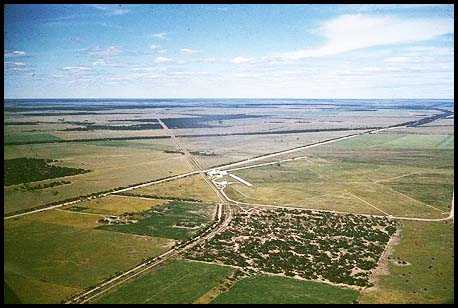 |
|
The Telegraph Office opened in 2 June 1885 - about nine months after the Post Office. It is on the Franklin Harbour and used to be sometimes referred to by that name. The Telegraph Office was located in the hotel in the room that had been used for bagatelle (billiards) and which was generously provided by the proprietors of the hotel. Alfred Howley was the telegraphist and Alfred Cole was his assistant. |
 Cowell Post & Telegraph Office in 1905. |
Deputations had been made to the Minister as early as May 1882 on the grounds that
Tenders were let for the construction of a Post & Telegraph Office in January 1888 for £398. A branch line connected Cowell to the main Port Augusta-Port Lincoln line and that line was completed by Mr. Knuckey, of Adelaide, in about three weeks. The telegraph was seen to be a great benefit to the district. About 277 km from Adelaide. |
| Fowlers Bay.
The Telegraph Office opened in May 1877 - about 12 years after the Post Office. The first Postmaster was Mr. E.N.B. Catchlove, who rejoiced in the full name of Edward Napoleon Bonaparte Catchlove.
|
|
||
| On 27 May 1879, a report on Fowlers Bay in the South Australian Register described the township as follows: "The township of Fowler's Bay is the most westerly in South Australia. Nestling under the lee of some half-bare sandhills— whose sides are fortunately consolidated by the growth of marine spinifex or else they might bury the houses — and close to the edge of the bay with an easterly aspect, the township consists of one three-roomed house; the telegraph office, a substantial stone building with a stable in the rear; the police-trooper's house which was built by one of the force and a long low barrack-like pile, once the head station but now the property of the Government, in which any casual may lodge at the easy rent | 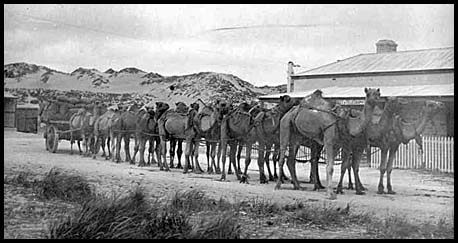 Camels arriving at Fowlers Bay, Yalata Station about 1913. Source: National Library of Australia: PRG280-1-16-100. |
||
| of one shilling per week. Although quite open to the south-east, Fowler's Bay affords good anchorage for small craft that can anchor in less than three fathoms".
A story in The Chronicle of 11 January 1940 reports observations of Michael Allen who had arrived in Fowlers Bay in 1887. The report begins: "There was only a telegraph office and a police station at Fowler's then. The latter was in charge of M.C. 'Jimmie' Dowling. The remainder of the population was chiefly blacks. Outback there were many whites hunting kangaroos. The skins were a great price". |
|||
|
On 26 August, 1867, a Post Office was opened at a location called Franklin Harbour located west of Cowell. On 1 November 1880, the Post Office changed locations to 3 km south of Cowell - but retained the name. It was located on the southern part of the entrance to Franklin Harbour. Walker (2004, p. 120) says that the Office in the first location changed its name to Wangaraleedenie on 1 November 1880. On 1 September 1881, Wangaraleedenie changed name to Cleve. The Franklin Harbour Post Office in the second location closed on 28 June 1886. The residents of this district - like those in many other districts - were angry they were unable to have a Telegraph Office opened there - despite the fact that the telegraph line to Western Australia passed within four miles of the Harbour. |
|
Conversations were being had about the need for a Telegraph Office at (Port) Elliston in the late 1870s. Waterloo Bay was the only place in that region offering shipping facilities and it adjoined Elliston. As was usual, there was discussion about whether that place or another not far distant would be the better location:
The Adelaide Observer of 30 April 1880 reported as follows:
The Telegraph Office opened in August 1881 as Port Elliston and changed name to Elliston almost immediately. The Post Office opened in September after being relocated and had a name change from Waterloo Bay. About 472 km from Adelaide. |
| Postal date stamps used on telegrams during the Colonial/Interim period. | |||
Port Lincoln framed date stamp. Used on 2d orange de La Rue. In 1879, the date stamp could have been used on a delivery form but not with a stamp on a transmission form.
|
|
|
|
| Date stamps used on telegrams during the Commonwealth period. |
Used on Birthday Greetings form AB-GB-39A. |
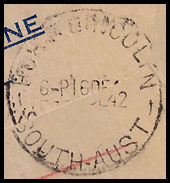 16 December 1942. SOUTH AUST at base. Small side arcs. Used on the reverse side of an envelope of type AB-EO-6B. Also see AB-DU-4Ba with one line date, S.A. at base and large side arcs. |
Used on AW-DO-10BB (50) |
|
Located about half way between Ceduna and Streaky Bay - about 37 km SE of Ceduna. A Post Office was opened in 1863 but closed in June 1868. It reopened in January 1897 and became an Official Office in September 1911 with Money Order facilities. The telegraph facilities at Smoky Bay were established about the end of 1876 but only as a Repeating Station. |
|
The reverse side of the postcard: Dear Ellien Many thanks for Xmas Greetings which arrived safely today. This is the Repeating Station Line. The central building is the PG engine room etc. The right is the residence and the one on the left is out domicile. The two rooms to the left are our bedrooms & living room. The lobby which you see at this end divides the house. |
 Image on a postcard posted 22 December 1917. |
We have 20 feet of ?? at the other end of the house with a partition either end for our kitchen. Twins love the PG end and the dining room on the other side of the house. We are just now over terrible weather. Wednesday 112°, Thursday 110° and Friday 114°. Today a lovely cool change saved our lives. Reice joins in sending the best of wishes for a prosperous New Year. Love from Muriel. |
|
|
The Telegraph Office opened on 6 October 1917, changed to a Receiving Office on 15 June 1922, then to a Post Office on 1 July 1927 before closing on 15 November 1927. |
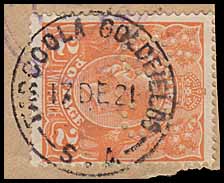 Tarcoola Goldfields 17 December 1921 (TO period). |
|
There was a critical need for a Post & Telegraph Office to be opened at Yardea in conjunction with the construction of the 1896 duplicate West-East telegraph line. Yardea was 143 miles west of Post Augusta. The tender submitted by Charles Geddes & CO of £418 was accepted with the Government carting the materials from Port Augusta West. The Office was opened in May 1897. Automatic quadruplex instruments were installed in the new Yardea office in 1898. |
|
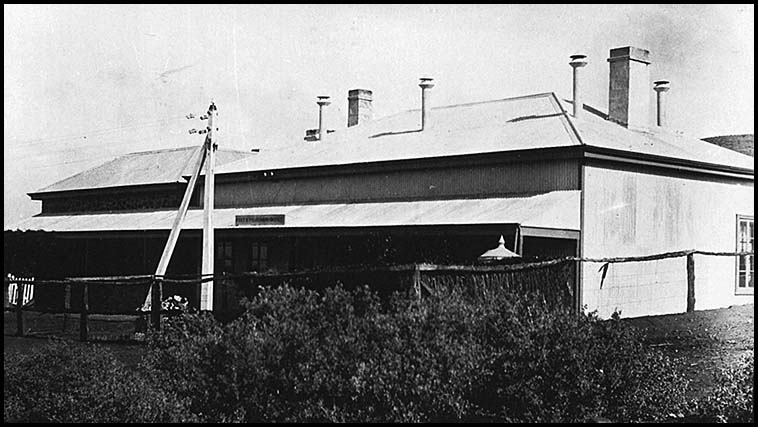 Yardea Telegraph Office about 1905. |
|
| Mr. A. Cole who had been the esteemed operator in the Port Lincoln Post and Telegraph Office was transferred to take charge of the new Yardea Office. He was very active in the local cricket club and with boating. He left "with the goodwill of the people and a generally expressed hope that his future career may be prosperous".
The Express of 8 June 1898 reported that "telegraphic results from the scrutiny of the Phillips Ponds and Yardea boxes in conjunction with the referendum (for the Colonies to vote for the Commonwealth of Australia) had been received. At the former place, five voted "YES" and at Yardea six voted the same way". |
|
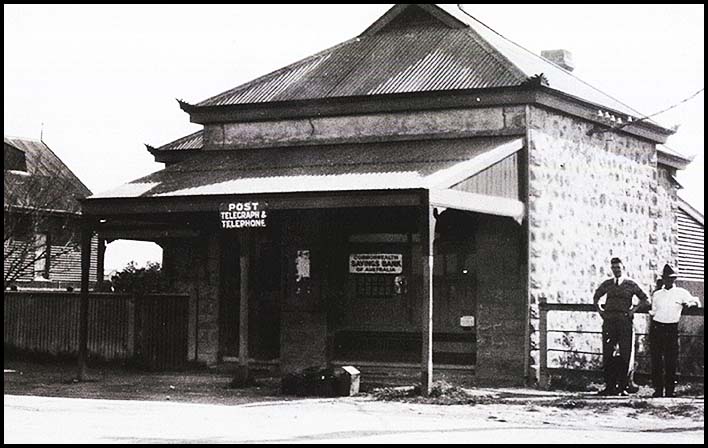
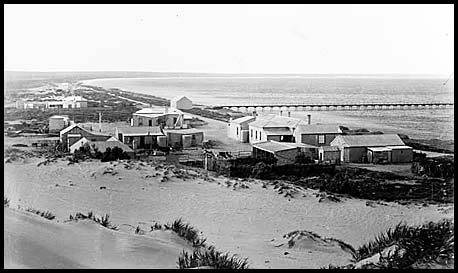
 Port Lincoln Telegraph Office on the left with St. Thomas Church of England behind it. The Institute is on the right. Picture taken in 1880.
Port Lincoln Telegraph Office on the left with St. Thomas Church of England behind it. The Institute is on the right. Picture taken in 1880.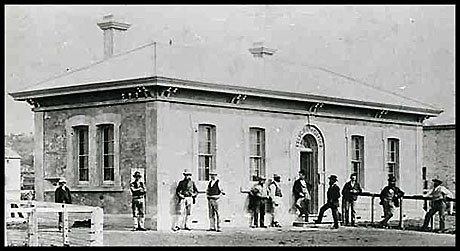 Port Lincoln Telegraph Office about 1900.
Port Lincoln Telegraph Office about 1900.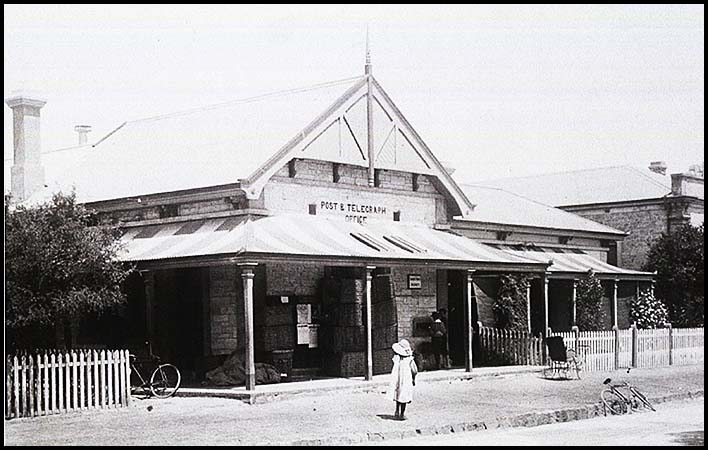
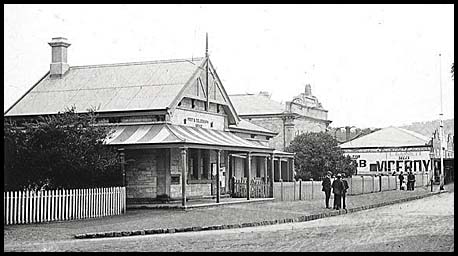
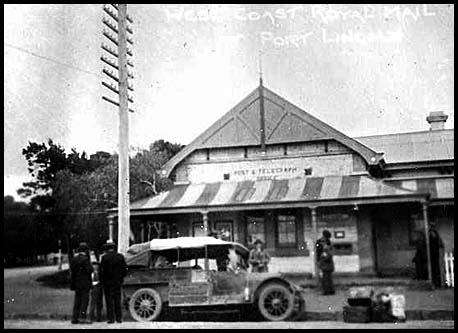 Port Lincoln Post & Telegraph Office 1922
Port Lincoln Post & Telegraph Office 1922